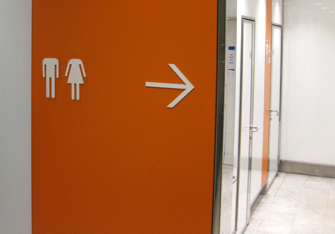
Due to humankind’s profligate use of natural resources, the world now teeters on the brink of a planet-wide disaster with no precedent in all of history. Unless of course you count when my first girlfriend in junior high dumped me. Now that was a catastrophe of global proportions.
France has been at the forefront of the efforts to address the problem, hosting the COP 21 Climate Change Conference in 2015 and, earlier this year, passing groundbreaking legislation to minimize food waste. Supermarkets are now required to donate out-of-date products to food banks. It makes sense: we’ve already been eating cheese that looks and smells like it should have been mulched months ago, so why not extend the principle to yogurt, meat and gummy bears?
Inspired by my adopted country’s example, I have decided to dedicate myself to exposing and denouncing other forms of waste wherever I see them. And I vow to continue, zealously and tirelessly, for as long as it takes. By which I mean as long as it takes to get an article out of it. After that, it’s every planet for itself.
The issue of waste has been on my mind since last summer, when I happened to notice a particularly blatant misuse of mineral resources while strolling the waterfront in the town of Trouville on the Normandy coast. Have a look:

You see?! Well, actually, I’m sure you don’t. But take a closer look at the door to the wheelhouse:
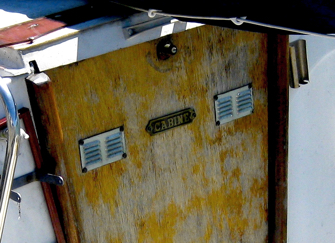
I’m so glad there’s a plaque on the door identifying the cabin! Otherwise how would anyone have any idea where it is? It’s so easy to get lost in the labyrinth of decks and corridors on those giant oceangoing vessels.
In fact, many instances of waste involve some kind of signage. I saw one of the worst cases last June while on vacation in Provence. Since it was lavender season, my wife and I decided to check out the blossoms at the Abbaye de Sénanque, a historic abbey famous for its lavender fields.
To be precise, I should say very, very, very, very famous for its lavender fields — the place was jammed beyond capacity with visitors. Many of whom were going out of their way to nullify the abbey’s attempts at crowd control:
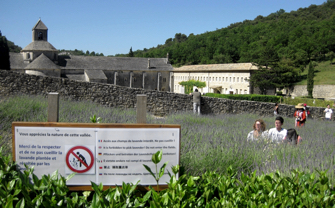
Here again, a closeup is in order to see what I’m talking about:
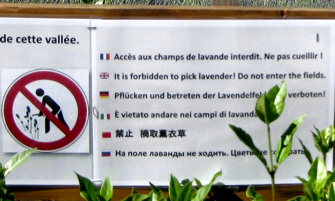
There were people —a lot more people than are visible in my photo — clambering over the fences and hedges, tromping right past this hexalingual sign and into the fields. Which part of “Pflücken und betreten der Lavendelfelder ist verboten” don’t they understand?
Closer to home, I found another example: for the benefit of the many Anglophone tourists who have trouble figuring out the ticket vending machines, the employees at my local Métro stop took it upon themselves to post a helpful explanatory note under the touchscreen. Oh wait — let’s just say “a note”:
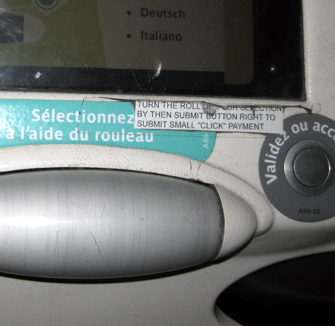
It’s hard to read due to wear and tear, but it says, “Turn the roll up your selection by then submit button right to submit small ’click’ payment.”
Got that? All right, then! Now get this:
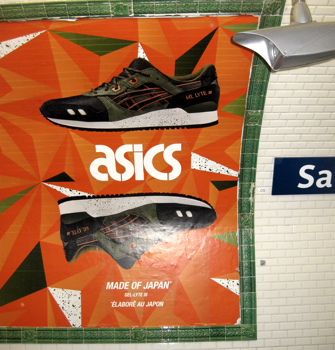
Yes, it’s an ad for sneakers in the Métro. So far so good, but, once more, take a closer look at the small print:
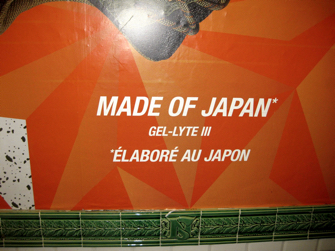
Sadly, print is not the only medium in which well-meaning French people have been trying, and failing, to express themselves in English. Consider this handbag on display in a Paris boutique:
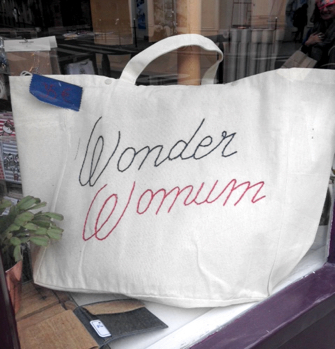
We all see what the embroiderer was trying to say, but we have to, ah, wonder what went wrong.
Still, a little thread is not such a terrible thing to waste. As opposed to, say, a ton or two of stone and mortar in this small town in Provence whose name I have now forgotten:
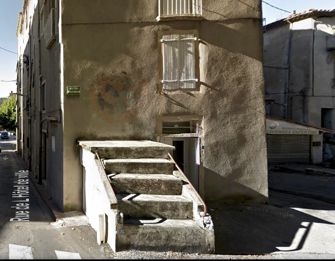
A lot of work went into the alteration of this building — why didn’t they finish the job? I imagine the conversation between the contractor and the owner going like this:
“Okay, we’ve installed a new door on the street level, sealed off the old entrance, plastered it over and resurfaced the whole wall so there’s no trace of the old doorway. Now we just need to break up those steps and haul away the stones.”
“No, don’t! Leave the steps — I might want to paint a jack-o-lantern up there someday and I don’t have a ladder.”
But back to Paris. Here’s a case that is undeniably, quintessentially Parisian. The city is, of course, famous for being the home of a great many artists and art museums. There’s fine art virtually everywhere you look. Including on the sidewalk:
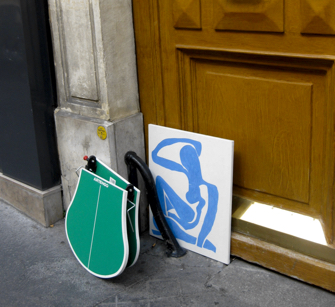
Paris! You can’t even walk down the street without tripping over a goddamn Matisse!
In fairness, I should point out that not everyone in France is wasteful. On Boulevard Voltaire a few weeks ago, I came across evidence of some devoted conservationist’s long-term effort to avoid needlessly replacing household furnishings merely because they’re a little old and out of style:
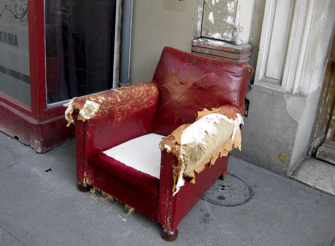
Presumably, the former owner of this chair sat in it one last time while it was in this very condition before finally deciding to throw it out. Another imagined conversation comes to mind:
“Honey, don’t you think it’s about time to get rid of that armchair?”
“Why? It’s still got plenty of good use in it!”
“Yes, obviously, but the color doesn’t really go with the new wallpaper.”
“Hmm. I see what you mean. I’ll leave it downstairs for that café with the red decor — I’m sure they’ll be glad to have it!”
Or he could have donated it to this bar on Rue du Faubourg Saint Denis:
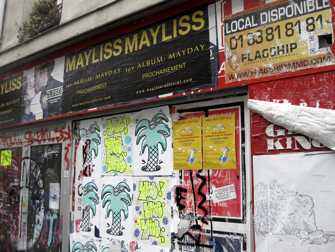
I’m not kidding here: this is the actual façade of Le Syndicat, one of Paris’s trendiest cocktail bars. Inside it’s all brand-new designer furniture, gilding and muted lighting, as you can see here, but outside the designers decided to leave the storefront just as they found it — after the place had sat empty, collecting geological strata of ad posters, for three or four years.
My photo doesn’t give a full view of the squalor-chic look of the place because there were some homeless guys sprawled on the sidewalk just in front, and I didn’t want them to think I was photographing them. Or maybe that was the owner and the bartender doing a little image-building.
But as a truly radical, outside-the-box (or outside-the-can) concept of waste recycling, I commend the example possibly represented by this statue in the otherwise thoroughly charming Provençal town of Saint Saturnin lès Apt:
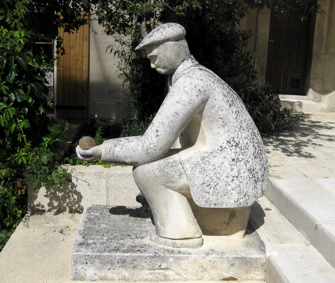
It’s supposed to be a sculpture of a man playing pétanque, the French version of lawn bowling that has become the unofficial national sport for people with no athletic skills, a competitive nature and nothing better to do. Which means a sizable portion of the population.
But given the figure’s posture, the unfortunate but evocative presence of the pedestal underneath it, and the even more unfortunate and evocative color of the sphere in his hand, I started to wonder: could this be a memorial to a visionary pioneer in the reuse of some kind of waste?
If so, it makes me proud to live in a country that not only shows concern for the state of the planet, but also, and more importantly, gives me an opportunity to finish this article with a revolting and hideous (not to mention irresponsible and unadmirable) pun.
France: the birthplace of the eco-movement!
© 2016 Paris Update
FavoriteAn album of David Jaggard’s comic compositions is now available for streaming on Spotify and Apple Music, for purchase (whole or track by track) on iTunes and Amazon, and on every other music downloading service in the known universe, under the title “Totally Unrelated.”
Note to readers: David Jaggard’s e-book Quorum of One: Satire 1998-2011 is available from Amazon as well as iTunes, iBookstore, Nook, Reader Store, Kobo, Copia and many other distributors.
